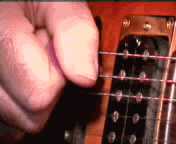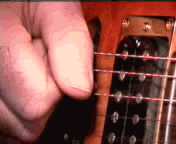Scroll through the lesson and click on notation/video/audio links to load the interactive players.
Please subscribe to get full access to all lessons for only $7.95/month PLUS 1 week free trial.

Riff Interactive lessons are
LESS expensive and
MORE interactive than alternatives!
More Info
|
|
| Lesson Subject:
Metallica Style |
| What you learn:
Runs - Part 2 |
| Teacher: Michael Johnson |
Michael: This is the second lesson in
our series on learning how to play runs used by Kirk Hemmitt in many of his Metallica solos. These runs are crucial to
helping you learn how to play fast
Metallica leads and will help you with basics to developing a sound of your own.
Sample some of the runs you'll learn in this lesson:
Michael:
If your beginning, spend more time practicing the scales, that will really help your hands
develop muscle memory and will allow you to build up your speed.
skud: Yea i need to work on my speed and feel.
Michael:
I'll give you a few to practice, it seems like the rest of you are into the Metallica leads.
ToddItami:
Teacher, I am just starting to learn scales should I always try to practice them with
alternative (sweep) picking?
Michael:
Yes Todd, let's start with the E minor Pentatonic scale.
Michael: This scale is
made up of 5 notes notes but over two octaves: E, G, A, B, D,
Kirk uses this scale often for runs, that's what we are going to focus on. If you're going to add a bend towards the end of the scale it is better to use the 3rd finger,
it's easier to bend notes. Try practicing the scales and coming runs over this jam track:
ToddItami: What is the exact definition of a "run"?
Michael: A "run" is a specific order of notes going up the scale or otherwise
known as a "sequence" of notes. A term used by many musicians. You can do a 4 note run:
E, G, A, B......
G, A, B, D....
A, B, D, E... etc
Let's try our first run using the E Minor Pen scale, here's what it should sound like fast:
Ed: Are you playing each note 3 times.
Michael: Yes,
3 at a time. Here's the video of the 3 note picking.
Michael: Here's the tab for the run slowed down for you to study.
Michael: This should help break it down, do you see how it uses the pentatonic pattern? Try playing it over the jam track,
you can also play this descending (backwards) the scale.
AceDuck: Could you possibly slow down and show how the triple-picking is done?
Michael: It's just down, up, down or a count of 1, 2, 3.
I'll do stop motion images.



stainless:
Holy cow, someone who hold the pick the same way I do.
Michael: Yes, I hold the pick at a slight angle.
ToddItami:
Angle toward your body?
Michael: Yes like in the picture.
stainless:
I do the three bend with 3 upstrokes...do you use a triplet for those (down up down)?
Michael: You can stainless, but I down pick on those. I slightly play in a small circle motion which catches the tip of the pick down and up.
OK lets try using runs in the E Dorian mode using the same alternate picking technique:
ToddItami: It almost looks like your thumb is west-east on the pick?
Michael: Almost, on this run you use the 1, 2, 4 fingers and the alternate picking.
AceDuck: Teach, do you rest your hand on the guitar?
Michael: Yes I do Ace, I place my palm over the bridge. Try the last scale over the jam track,
it has a very cool sound. Here's a different jam track you can play over:
Michael: This is a different style Metallica type jam, the Dorian is the second mode of a key.
Try
playing the scale down and up quite a few times, and then try breaking it up in sections.
Here's the run I gave you earlier.
kevin: Is there any particular scale that you can practice going up and down the neck, like really fast.
Michael: Kevin I like the scales that use 3 fingers per string any of the minor scale or modes.
They sound the fastest because your playing more notes per sting.
Ed:
3 fingers per string seems to be a "secret" to playing like this, right?
Michael: That's right, chromatic scales are very cool also, they usually use 4 notes per string.
Chris:
Hey teach, is the pentatonic a very good one to use?
Michael: That's a little harder to play fast, you have to rely on you picking speed more to sound fast.
kevin: What's the average time I should practice per day?
Michael: As much as possible, but it depends on your schedule of course. I use to play ALL day when I was learning.
The next run uses the same scale but it plays triads up the scale pattern on the bottom two strings,
here's what it sounds like fast:
kevin:
I try at least an hour a day, but I seem to be playing the same licks over and over.
Michael: Notice how the last track has a different sound, here's the pattern we'll use:
Michael: Notice the notes are sets of 3s using the E Dorian scale pattern on the bottom 2 strings.
Here's how the notes are broken down into triads using the last pattern I sent.
Michael: Here's the last run.
Michael: Do you all see how the triads use the scale pattern I sent earlier? The fun part is playing it over the jam track.
AceDuck: That "circular motion" thing helps :)
Michael: It makes a big difference!
Spend a lot of time on these runs, this will make all the difference in your
playing, believe me, the rewards are well worth it! See you next lesson!
|
<< load notation from left
|
|
<< load audio from left
|
<< load audio from left
|